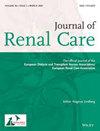Clinician Perspectives on Using Plastic Cannula for Vascular Access in Haemodialysis: Outcomes of a National Web-Based Survey
Abstract
Background
Plastic cannulae were introduced into Australia over a decade ago as a safer alternative to metal dialysis needles for arteriovenous fistula cannulation, decreasing the risk of infiltration resulting in haematoma formation, bruising, and pain for patients.
Objectives
To explore the uptake and current practices for using plastic cannulae for vascular access in Australian dialysis units.
Design
A 31-item exploratory descriptive web-based cross-sectional survey.
Participants
Renal clinicians who cannulate arteriovenous fistulae or arteriovenous grafts for haemodialysis in Australian haemodialysis units.
Results
A total of 185 clinicians responded to the questionnaire, with the majority of respondents from the Australian east coast Australia, specifically Queensland (36%, n = 66), New South Wales (27%, n = 50) and Victoria (26%, n = 48). Sixty-five percent of respondents were either registered nurses (47%, n = 88) or clinical nurse specialists (18%, n = 34). Of 140 participants who reported plastic cannula availability, only 62 (44%) used them personally. Plastic cannulae were mainly used with new (n = 55/65, 85%) and established (n = 56/60, 90%) vascular access, but rarely in home haemodialysis (n = 7/60, 11%). Plastic cannula was commonly used for the first 2 weeks with new fistula, then switched to metal needles due to high cost, however 41% (n = 22/54) reported that decisions on long-term cannula use was based on patient clinical needs. Training and gauge of cannula varied by state, with 16-guage the most common.
Conclusion
Plastic cannula use is increasing across Australia, but cost and training barriers still exist. Nevertheless, plastic cannulae remain a viable alternative to metal needles.

 求助内容:
求助内容: 应助结果提醒方式:
应助结果提醒方式:


